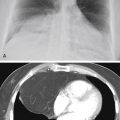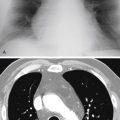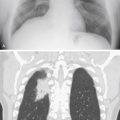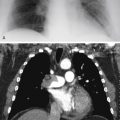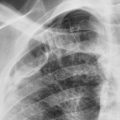Abstract
Shift of the mediastinum indicates an imbalance of intrathoracic pressures. The mass effect of a large pleural effusion, pneumothorax, or intrathoracic mass will shift the mediastinum away from the primary abnormality whereas collapse of a lung caused by bronchial obstruction will shift the mediastinum toward the primary abnormality.
Keywords
air-trapping, asymmetric lung volume, atelectasis, bullous emphysema, CPAM, diaphragmatic hernias, hypoplastic lung, lateral decubitus chest x-ray, ruptured diaphragm, tension hydrothorax, tension pneumothorax
Questions
- 1.
Regarding the case shown in Fig. 7.1, A and B , which one of the following statements is incorrect?
- a.
The right lung is overinflated.
- b.
There is herniation of the right lung in front of the ascending aorta.
- c.
Left pleural effusion is compressing the left lung.
- d.
An endobronchial mass or mucous plug should be considered.
- e.
The most significant abnormality may not be visible on this examination.
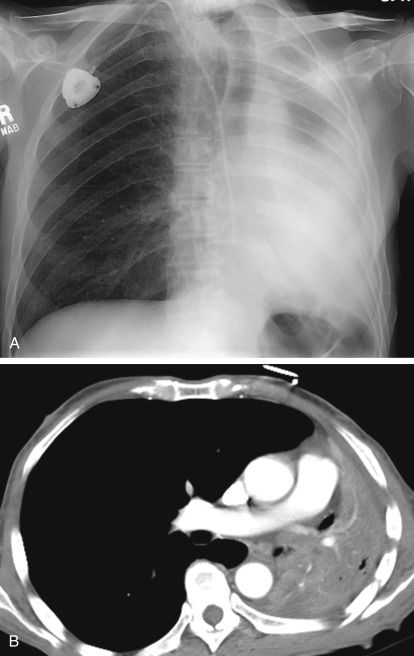
Fig. 7.1
- a.
- 2.
Referring to Fig. 7.2 , indicate which one of the following statements is not true of tension pneumothorax:
- a.
Collections of air may mimic the appearance of herniation of the lung through the mediastinum.
- b.
Shift of the mediastinum may be life-threatening.
- c.
Air may collect medially to the lung.
- d.
The anterior junction line may shift.
- e.
There is always complete collapse of the lung.

Fig. 7.2
- a.
- 3.
A premature infant in neonatal intensive care has a unilateral lucent lung with a contralateral shift of the mediastinum. Which one of the following is the most likely diagnosis?
- a.
Congenital pulmonary airway malformation (CPAM).
- b.
Bronchogenic cyst.
- c.
Congenital lobar overdistention.
- d.
Pulmonary interstitial emphysema (PIE).
- e.
Bronchial obstruction.
- a.
Discussion
Shift of the mediastinum ( Chart 7.1 ) is identified by displacement of the heart, trachea, aorta, and hilar vessels. Because shift of the mediastinum indicates an imbalance of pressures between the two sides of the thorax, one of the first steps in the evaluation of this problem is to determine which side is abnormal. Associated findings are frequently helpful in making this determination. For example, atelectasis is frequently associated with elevation of the hemidiaphragm and crowding of the ribs, as well as increased opacity of the lung. It is also frequently accompanied by overexpansion of the contralateral side of the chest, which is described as compensatory overaeration. In the absence of diaphragmatic elevation, the possibility that the overexpanded lung is the abnormal one has to be considered; the overexpanded lung could be compressing the normal lung, resulting in increased opacity on the normal side. The radiologist has two important tools for making this determination. The best-known method is the expiratory examination, which will demonstrate that air moves freely from the overexpanded side when it is the normal side and will show that the underexpanded lung is essentially unchanged, confirming the diagnosis of atelectasis. In contrast, air trapping in an overexpanded lung will be exaggerated.
- I.
Decreased lung volume
- A.
Atelectasis
- B.
Hypoplastic lung
- C.
Postoperative (e.g., lobectomy, pneumonectomy)
- A.
- II.
Pleural space abnormalities 588
- A.
Large unilateral pleural effusion 358
- B.
Tension pneumothorax
- C.
Large diaphragmatic hernias (congenital or posttraumatic)
- A.
- III.
Increased lung volume in adults
- A.
Asymmetric bullous emphysema
- B.
Large masses (e.g., pulmonary, mediastinal, chest wall)
- C.
Bronchiolitis obliterans (Swyer-James syndrome; rare)
- D.
Bronchopulmonary sequestration (rare)
- E.
Bronchogenic cyst (rare)
- A.
- IV.
Increased lung volume in young children
- A.
Congenital lobar overdistention
- B.
Interstitial emphysema
- C.
CPAM
- D.
Aspirated foreign body
- A.
When the patient is unable to cooperate, the best substitute for the expiratory examination is the lateral decubitus view. In this procedure the overexpanded side should be down, with the effect of splinting the down side. The radiologic result is similar to that of the expiratory examination. An overexpanded lung that remains overexpanded in the down position indicates bronchial obstruction with obstructive overaeration. The lateral decubitus examination is particularly helpful in a child who has a foreign body in the bronchus. If the overexpanded lung resumes normal size in the down position, the smaller lung can be assumed to be abnormal.
Fluoroscopy is another method for evaluating a shift of the mediastinum. In the case of atelectasis that has resulted from an endobronchial mass, deep inspiration causes the mediastinum to shift more toward the side of the atelectasis, whereas the diaphragm moves normally on the overexpanded side. Fluoroscopic examination will reveal that air trapping causes a shift of the mediastinum away from the lucent side during forced expiration.
Decreased Lung Volume
Loss of lung volume is an important cause of a shift of the mediastinum. The case shown in Fig. 7.1, A and B illustrates a shift of the mediastinum caused by a lung cancer arising in the left main bronchus. There is total atelectasis of the left lung with compensatory overinflation of the right lung and herniation of the lung in front of the anterior mediastinum. There is no evidence of left pleural fluid. (Answer to question 1 is c. ) The various types of atelectasis, which are considered in Chapter 13 , may all result in a shift of the mediastinum. It should also be apparent that lobectomy and pneumonectomy are common causes of a mediastinal shift. In fact, a shift of the heart and mediastinum accounts for much of the thoracic opacity that follows pneumonectomy.
A hypoplastic lung is a rare anomaly that results in a characteristic radiologic appearance consisting of a small hemithorax with crowding of the ribs, elevation of the hemidiaphragm, shift of the mediastinum, and an absent or very small pulmonary artery on the involved side. In addition to the small or absent hilar pulmonary artery, the peripheral vascularity of the involved lung is primarily bronchial with small irregular vessels lacking the normal hilar orientation of pulmonary arteries. This phenomenon is usually referred to as a hypogenetic lung or congenital venolobar syndrome . 654 , 670 It is usually seen on the right and is frequently associated with dextrocardia and anomalous pulmonary venous return from the right lung to the inferior vena cava. When the anomalous venous drainage is radiologically visible as a large vein coursing through the right lung to the inferior vena cava, the so-called scimitar syndrome is said to be present. Signs of decreased lung size with a shift of the mediastinum or elevation of the diaphragm need not be present to suggest the diagnosis of hypogenetic lung syndrome when the characteristic vascular changes are present ( Fig. 7.3 ).



